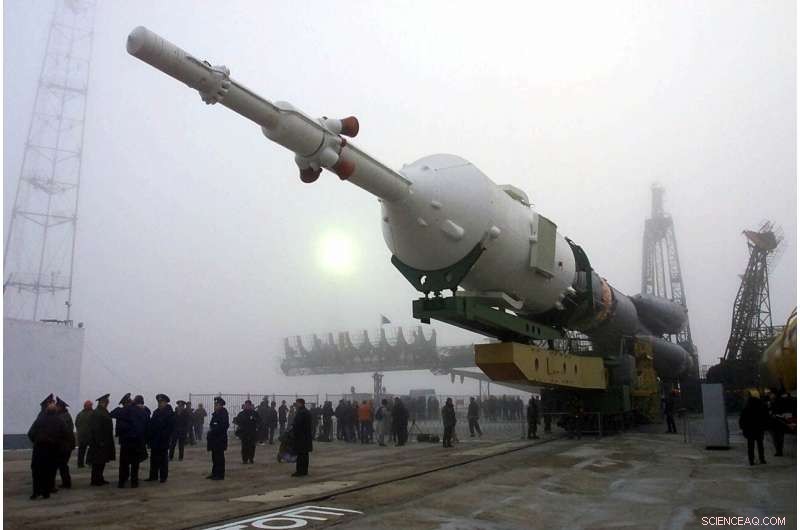
In questo 29 ottobre, 2000, foto d'archivio, il booster Soyuz viene trasportato alla rampa di lancio presso il cosmodromo di Baikonur in Kazakistan. Due giorni dopo, L'astronauta statunitense Bill Shepherd, e i cosmonauti russi Sergei Krikalyov e Yuri Gidzenko sono decollati per diventare i primi residenti sulla Stazione Spaziale Internazionale. (Foto AP/Mikhail Metzel, File)
La Stazione Spaziale Internazionale era un angusto, umido, minuscole tre stanze quando vi si trasferì il primo equipaggio. Vent'anni e 241 visitatori dopo, il complesso è dotato di torre di avvistamento, tre bagni, sei vani letto e 12 camere, a seconda di come conti.
Lunedì segna due decenni di un flusso costante di persone che vivono lì.
Gli astronauti di 19 paesi hanno fluttuato attraverso i portelli della stazione spaziale, compresi molti visitatori abituali che sono arrivati su navette per lavori di costruzione a breve termine, e diversi turisti che hanno pagato a modo loro.
Il primo equipaggio, l'americano Bill Shepherd e i russi Sergei Krikalev e Yuri Gidzenko, è decollato dal Kazakistan il 31 ottobre. 2000. Due giorni dopo, spalancarono le porte della stazione spaziale, stringendo le mani in unità.
Pastore, un ex Navy SEAL che ha servito come comandante della stazione, lo paragonava a vivere su una nave in mare. I tre passavano la maggior parte del tempo a convincere l'attrezzatura a lavorare; sistemi balky hanno reso il posto troppo caldo. Le condizioni erano primitive, rispetto ad ora.
Le installazioni e le riparazioni hanno richiesto ore presso la nuova stazione spaziale, contro i minuti a terra, Krikalev ha ricordato.
"Ogni giorno sembrava avere la sua serie di sfide, "Ha detto Shepherd durante una recente tavola rotonda della NASA con i suoi compagni di equipaggio.
Da allora la stazione spaziale si è trasformata in un complesso lungo quasi quanto un campo da calcio, con otto miglia (13 chilometri) di cavi elettrici, un acro di pannelli solari e tre laboratori high-tech.
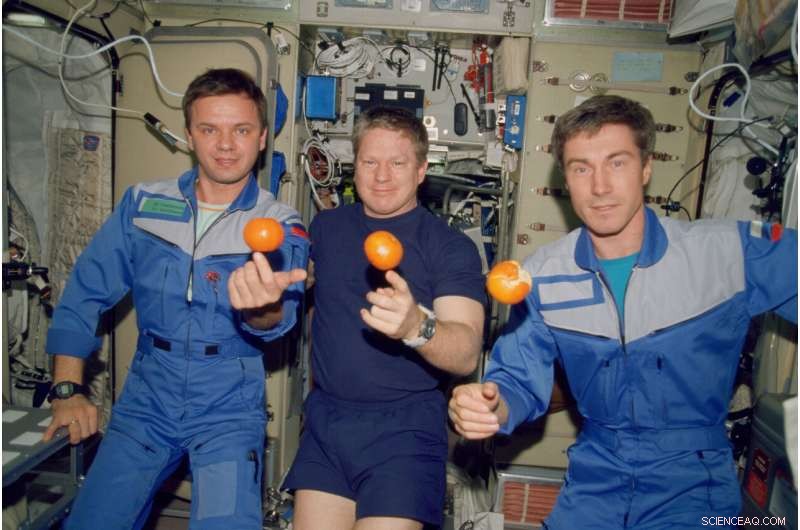
In questa foto fornita dalla NASA, i membri dell'equipaggio della Expedition 1 posano con arance fresche a bordo del modulo di servizio Zvezda della Stazione Spaziale Internazionale in orbita attorno alla Terra il 4 dicembre, 2000. Nella foto, da sinistra, sono il cosmonauta Yuri P. Gidzenko, comandante della Sojuz; l'astronauta Bill Shepherd, comandante della missione; e il cosmonauta Sergei K. Krikalev, ingegnere di volo. (NASA tramite AP)
"Sono 500 tonnellate di cose che sfrecciano nello spazio, la maggior parte dei quali non si sono mai toccati fino a quando non si sono alzati lassù e sono saltati su, " Shepherd ha detto all'Associated Press. "E tutto è andato avanti per 20 anni senza quasi grossi problemi".
"È una vera testimonianza di ciò che si può fare in questo tipo di programmi, " Egli ha detto.
Pastore, 71, è da tempo in pensione dalla NASA e vive a Virginia Beach, Virginia. Krikalev, 62, e Gidzenko, 58, sono saliti nei ranghi spaziali russi. Entrambi sono stati coinvolti nel lancio a metà ottobre del 64esimo equipaggio.
La prima cosa che i tre fecero una volta arrivati alla stazione spaziale oscurata il 2 novembre, 2000, era accendere le luci, che Krikalev ha ricordato come "molto memorabile". Quindi hanno riscaldato l'acqua per le bevande calde e attivato il bagno solitario.
"Ora possiamo vivere, " Gidzenko ricorda che Shepherd disse. "Abbiamo luci, abbiamo l'acqua calda e abbiamo il bagno."
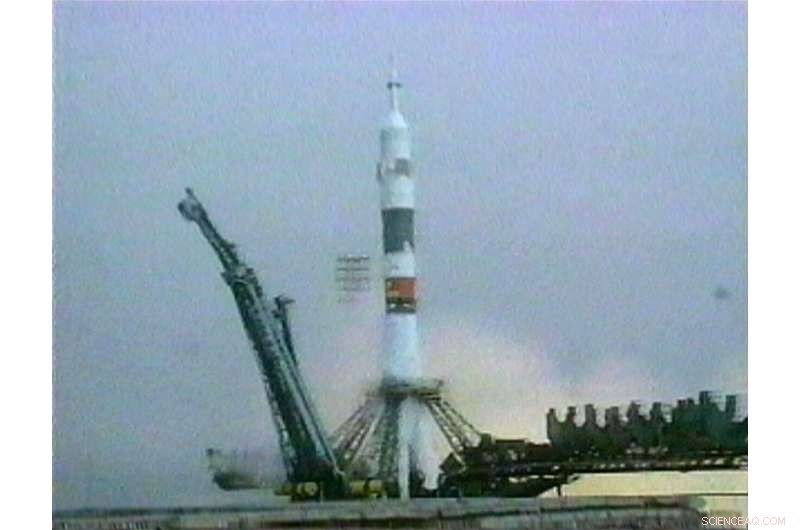
In questo 31 ottobre, 2000, file immagine dal video fornito dalla NASA, una nuvola di fumo circonda il razzo Soyuz pochi secondi prima del decollo dal cosmodromo di Baikonur in Kazakistan, trasportando i primi residenti della Stazione Spaziale Internazionale. Due giorni dopo, L'astronauta statunitense Bill Shepherd, e i cosmonauti russi Sergei Krikalev, e Yuri Gidzenko sono arrivati alla stazione spaziale. (NASA tramite AP, File)
L'equipaggio ha chiamato la loro nuova casa Alpha, ma il nome non è rimasto.
Sebbene pionieristico nel modo, i tre non hanno avuto contatti ravvicinati durante i loro quasi cinque mesi lassù, pastore ha detto, e finora la stazione ha retto relativamente bene.
NASA's top concern nowadays is the growing threat from space junk. Quest'anno, the orbiting lab has had to dodge debris three times.
As for station amenities, astronauts now have near-continuous communication with flight controllers and even an internet phone for personal use. The first crew had sporadic radio contact with the ground; communication blackouts could last hours.
While the three astronauts got along fine, tension sometimes bubbled up between them and the two Mission Controls, in Houston and outside Moscow. Shepherd got so frustrated with the "conflicting marching orders" that he insisted they come up with a single plan.
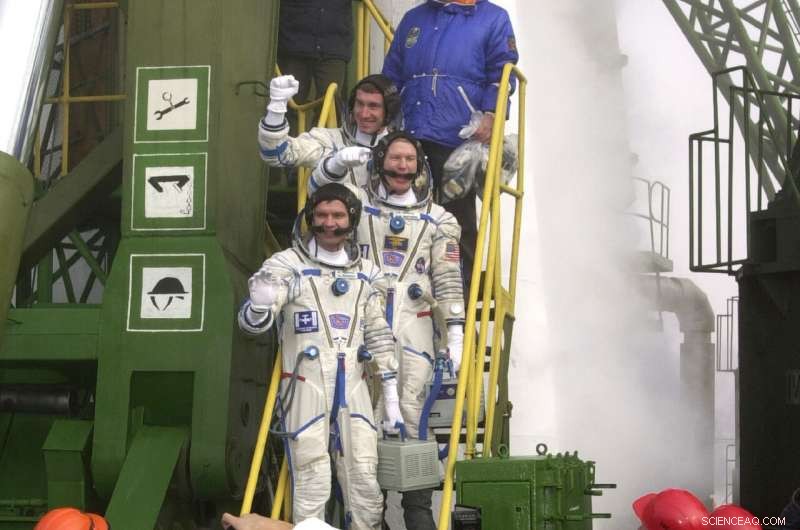
In this Oct. 31, 2000, foto fornita dalla NASA, Expedition 1 crew members, from top, Sergei K. Krikalev, Bill Shepherd and Yuri P. Gidzenko pose for final photos prior to their launch aboard a Soyuz rocket to the International Space Station from the Baikonur Cosmodrome in Kazakhstan. Two days later, they swung open the space station doors, clasping their hands in unity. Thus began 20 years of international cooperation and a steady stream of crew from around the world. (NASA tramite AP)
"I've got to say, that was my happiest day in space, " he said during the panel discussion.
With its first piece launched in 1998, the International Space Station already has logged 22 years in orbit. NASA and its partners contend it easily has several years of usefulness left 260 miles (400 kilometers) up.
The Mir station—home to Krikalev and Gidzenko in the late 1980s and 1990s—operated for 15 years before being guided to a fiery reentry over the Pacific in 2001. Russia's earlier stations and America's 1970s Skylab had much shorter life spans, as did China's much more recent orbital outposts.
Astronauts spend most of their six-month stints these days keeping the space station running and performing science experiments. A few have even spent close to a year up there on a single flight, serving as medical guinea pigs. Shepherd and his crew, al contrario, barely had time for a handful of experiments.
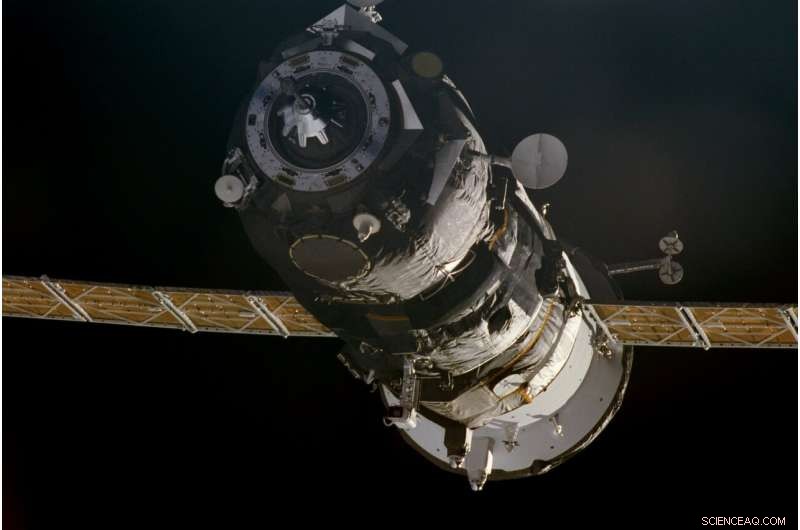
This photo provided by NASA shows a Progress supply ship that arrived on Nov. 18, 2000 to link up to the International Space Station, bringing Expedition 1 commander Bill Shepherd, pilot Yuri P. Gidzenko and flight engineer Sergei K. Krikalev two tons of food, capi di abbigliamento, hardware and holiday gifts from their families. (NASA tramite AP)
The first couple weeks were so hectic—"just working and working and working, " according to Gidzenko—that they didn't shave for days. It took awhile just to find the razors.
Even back then, the crew's favorite pastime was gazing down at Earth. It takes a mere 90 minutes for the station to circle the world, allowing astronauts to soak in a staggering 16 sunrises and 16 sunsets each day.
The current residents—one American and two Russians, just like the original crew—plan to celebrate Monday's milestone by sharing a special dinner, enjoying the views of Earth and remembering all the crews who came before them, especially the first.
But it won't be a day off:"Probably we'll be celebrating this day by hard work, " Sergei Kud-Sverchkov said Friday from orbit.
One of the best outcomes of 20 years of continuous space habitation, according to Shepherd, is astronaut diversity.
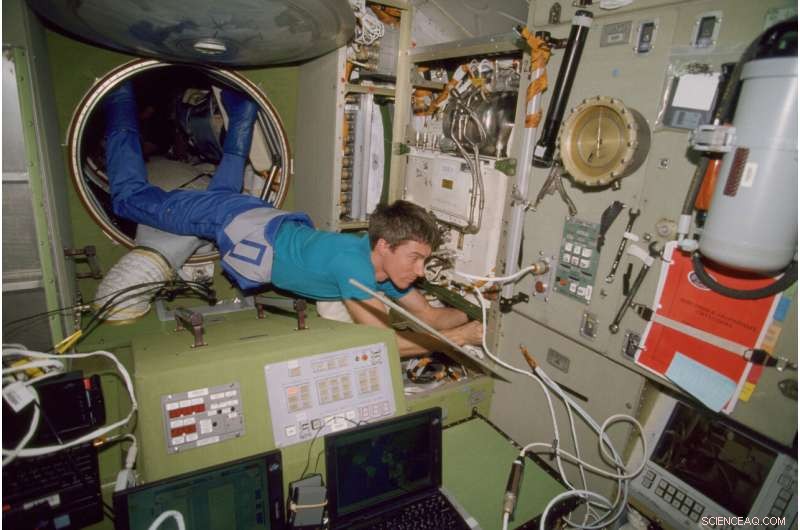
In questa foto fornita dalla NASA, Expedition 1 flight engineer Sergei K. Krikalev works in the Zvezda Service Module, with his feet anchored in a tunnel hatchway, aboard the International Space Station on Dec. 6, 2000. The space station was cramped and humid with just three rooms when the first crew moved in. Conditions were primitive, compared with now, and the three spent most of their time coaxing equipment to work. In the past twenty years, the space station has morphed into a complex that's almost as long as a football field, with eight miles (13 kilometers) of electrical wiring and three high-tech labs. (NASA tramite AP)
While men still lead the pack, more crews include women. Two U.S. women have served as space station skipper. Commanders typically are American or Russian, but have also come from Belgium, Germania, Italia, Canada and Japan. While African-Americans have made short visits to the space station, the first Black resident is due to arrive in mid-November on SpaceX's second astronaut flight.
Massive undertakings like human Mars trips can benefit from the past two decades of international experience and cooperation, Shepherd said.
"If you look at the space station program today, it's a blueprint on how to do it. All those questions about how this should be organized and what it's going to look like, the big questions are already behind us, " he told the AP.
Russia, ad esempio, kept station crews coming and going after NASA's Columbia disaster in 2003 and after the shuttles retired in 2011.
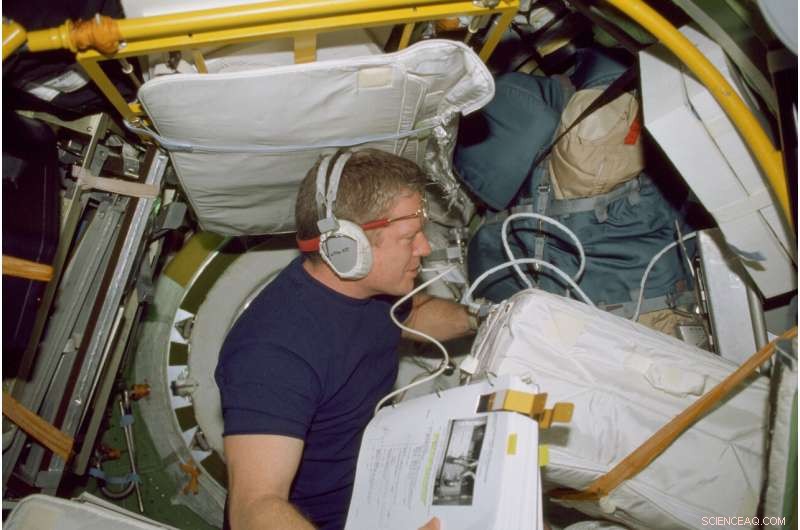
In questa foto fornita dalla NASA, Expedition 1 mission commander Bill Shepherd works in a docking compartment aboard the International Space Station on Dec. 5, 2000. The International Space Station was a cramped, humid, puny three rooms when the first crew moved in. Twenty years and 241 residents later, the complex has a domed lookout, three toilets, six sleeping compartments and 10 rooms, depending on how you count. (NASA tramite AP)
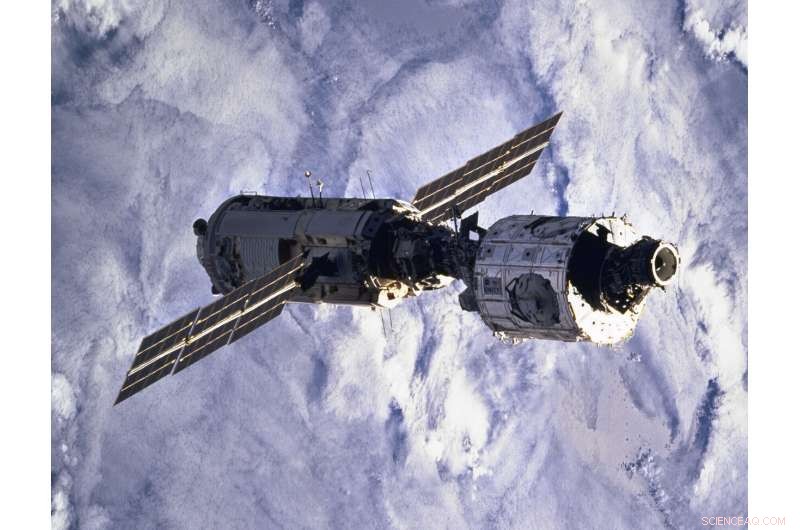
This photo provided by NASA shows the new International Space Station after the crew of the Space Shuttle Endeavour captured the Zarya Control Module, sinistra, and mated it with the Unity Node, Giusto, inside the Shuttle's payload bay. This photo was taken after Endeavour undocked from the space station on Dec. 13, 1998, for the return to Earth. Almost two years later, the first crew—American Bill Shepherd and Russians Sergei Krikalev and Yuri Gidzenko—blasted off from Kazakhstan on Oct. 31, 2000, en route to the space station. Thus began 20 years of international cooperation and a steady stream of crew from around the world. (NASA tramite AP)
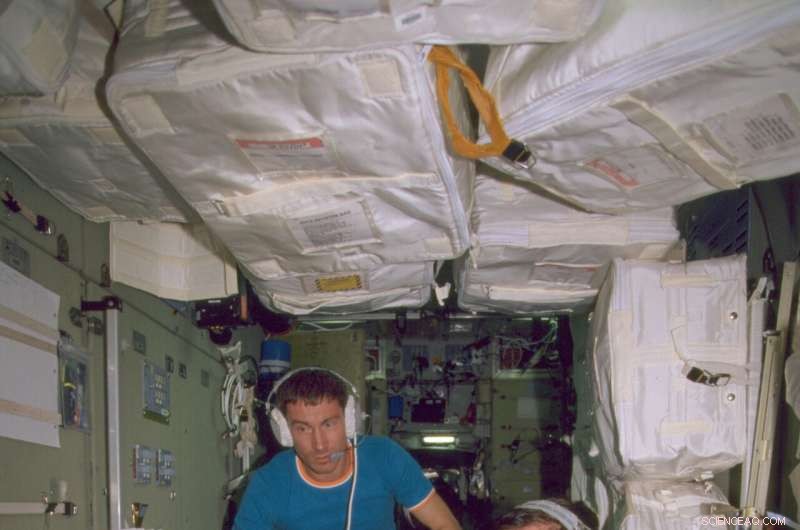
In questa foto fornita dalla NASA, Expedition 1 crew members Sergei Krikalev, sinistra, and Yuri Gidzenko work in the Zvezda Service Module onboard the International Space Station on Nov. 8, 2000. The first crew, Russians Krikalev and Gidzenko along with American Bill Shepherd, spent most of their time coaxing equipment to work in the cramped and humid three-room space station. Twenty years and 241 residents later, the complex is almost as long as a football field, with six sleeping compartments, three toilets, a domed lookout and three high-tech labs. (NASA tramite AP)
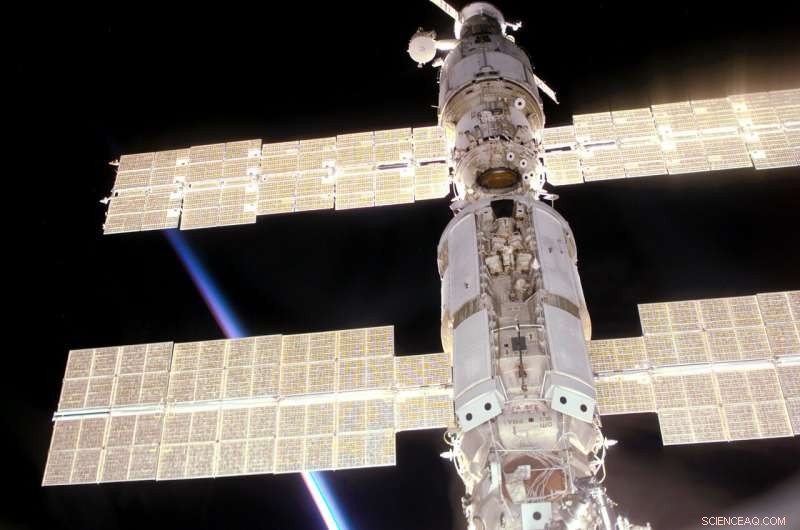
This photo provided by NASA shows the International Space Station as seen from Space Shuttle Atlantis during mission STS-106, which delivered supplies and performed maintenance in September 2000. The first crew of the space station—American Bill Shepherd and Russians Sergei Krikalev and Yuri Gidzenko—arrived less than two months later. Thus began 20 years of international cooperation and a steady stream of crew from around the world. (NASA tramite AP)
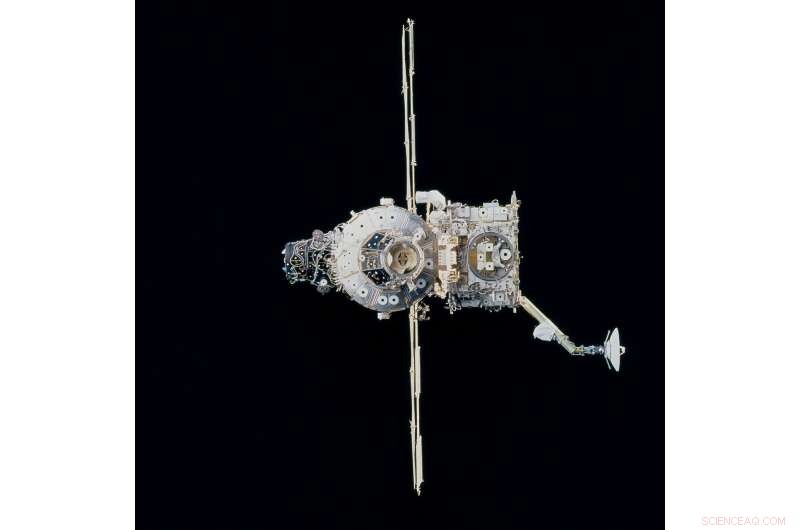
This Oct. 20, 2000 photo made available by NASA shows the International Space Station after separation of the Space Shuttle Discovery. Backdropped against the blackness of space, the Z1 Truss structure and its antenna, as well as the new pressurized mating adapter (PMA-3), are visible in the foreground. (NASA tramite AP)
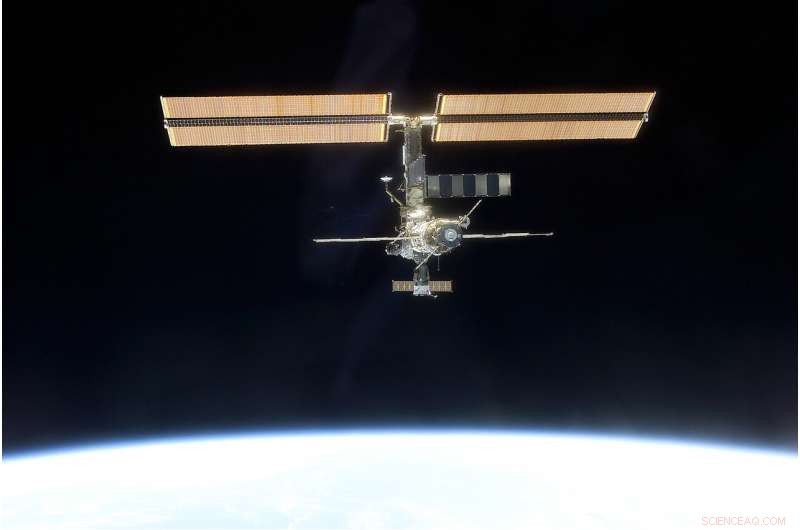
In questa foto fornita dalla NASA, the International Space Station, backdropped against black space above Earth's horizon, is seen from the Space Shuttle Discovery on March 19, 2001, after a new crew comprised of cosmonaut Yury Usachev and astronauts James Voss and Susan Helms began several months aboard the station. In the early days of the station, it was a cramped and humid, with just three rooms. It's much larger now, with six sleeping compartments, three toilets, a domed lookout and three high-tech labs. (NASA tramite AP)
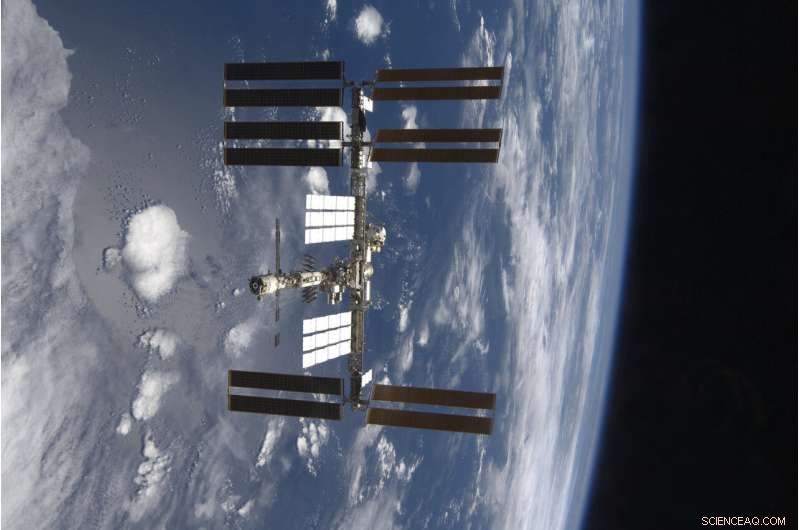
This photo provided by NASA shows the International Space Station as seen from Space Shuttle Endeavour as the two spacecraft begin their relative separation on Nov. 28, 2008. Twenty years after the first crew arrived at the space station, the spacecraft has hosted 241 residents and grown from three cramped and humid rooms to a complex almost as long as a football field, with six sleeping compartments, three toilets, a domed lookout and three high-tech labs. (NASA tramite AP)
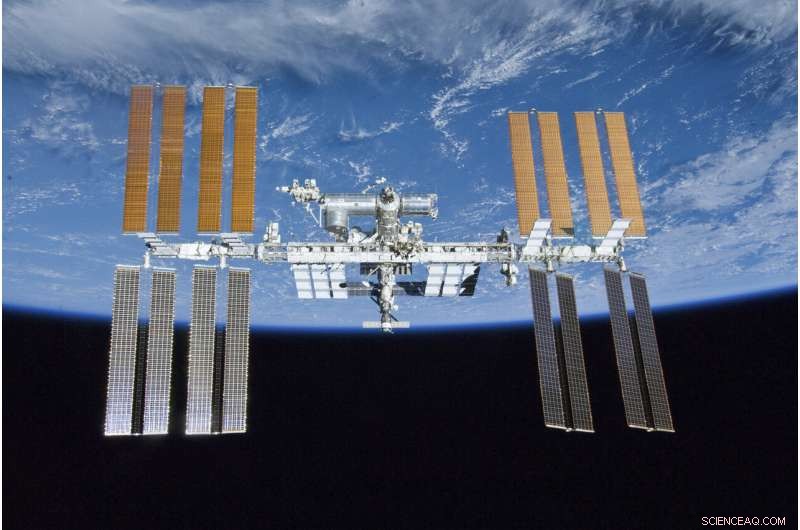
This photo provided by NASA shows the International Space Station as seen from the Space Shuttle Atlantis after the station and shuttle began their post-undocking relative separation on May 23, 2010. Twenty years after the first crew arrived, the space station has hosted 241 residents and grown from three cramped and humid rooms to a complex almost as long as a football field, with six sleeping compartments, three toilets, a domed lookout and three high-tech labs. (NASA tramite AP)
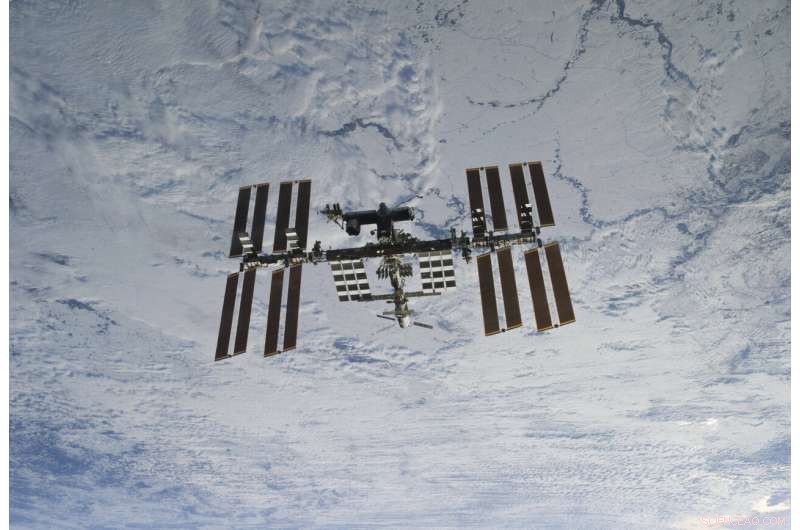
In questa foto fornita dalla NASA, backdropped against clouds over Earth, the International Space Station is seen from Space Shuttle Discovery as the two orbital spacecraft accomplish their relative separation on March 7, 2011. From the first crew to the most recent, the No. 1 pastime aboard the station is gazing down at Earth. It takes just 90 minutes to circle the world, allowing crews to soak in a staggering 16 sunrises and 16 sunsets every day. (NASA tramite AP)
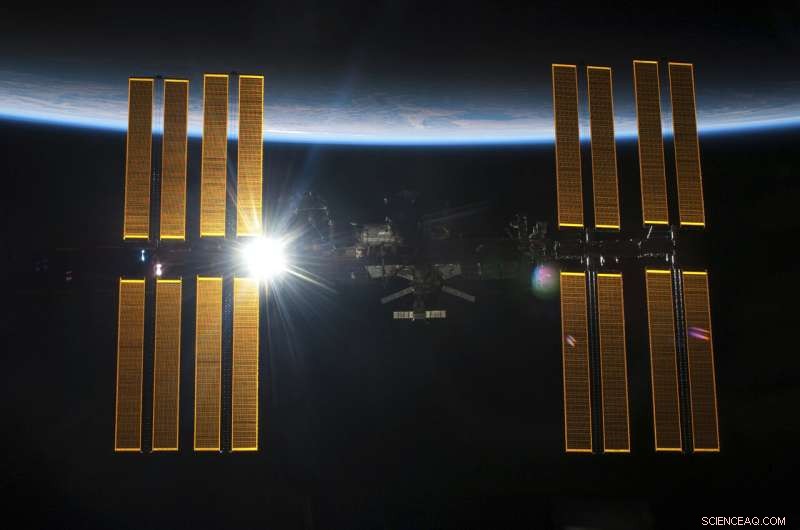
In questa immagine fornita dalla NASA, the International Space Station is seen from the Space Shuttle Endeavour on May 29, 2011, after the station and shuttle began their post-undocking relative separation. It takes just 90 minutes for the space station to circle the world, allowing crews to see 16 sunrises and 16 sunsets every day. (NASA tramite AP)
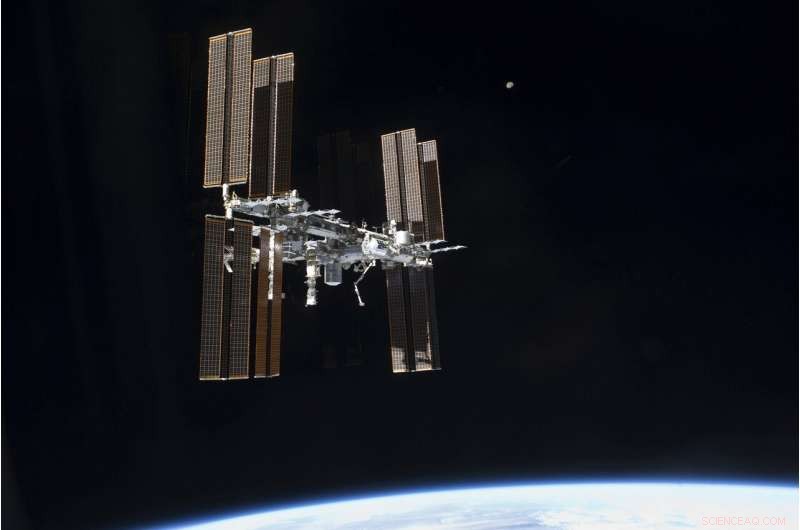
In questa foto fornita dalla NASA, the International Space Station is seen from the Space Shuttle Atlantis as the two spacecraft perform their relative separation on July 19, 2011. Above and to the right of the space station is the moon far in the distance. (NASA tramite AP)
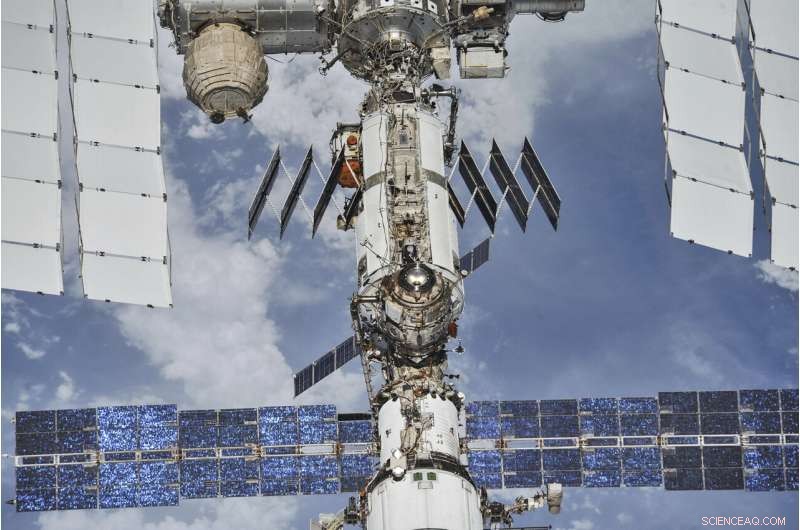
In this photo provided by NASA/Roscosmos, the International Space Station floats above the Earth as seen from a Soyuz spacecraft after undocking on Oct. 4, 2018. NASA astronauts Andrew Feustel and Ricky Arnold and Roscosmos cosmonaut Oleg Artemyev executed a fly around of the orbiting laboratory to take pictures of the station before returning home after spending 197 days in space. Twenty years after the first crew arrived, the space station has hosted 241 residents. (NASA/Roscosmos via AP)
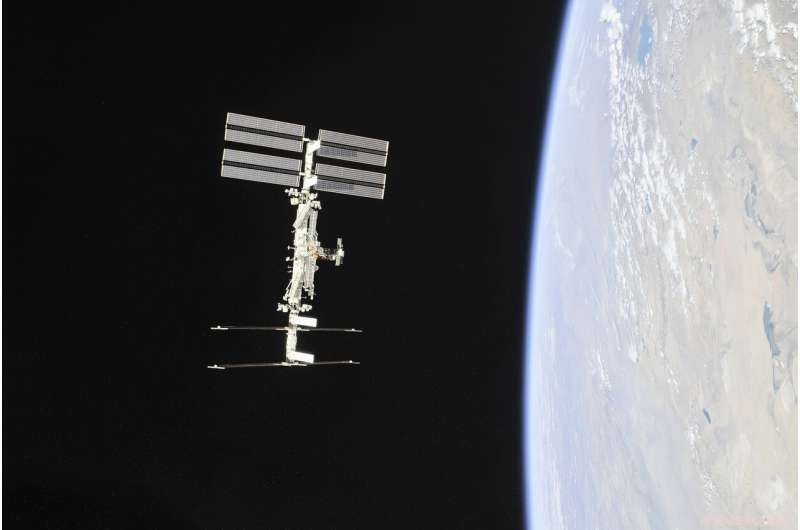
In this photo provided by NASA/Roscosmos, the International Space Station continues its orbit around the Earth as seen from a Soyuz spacecraft departing with NASA astronauts Andrew Feustel and Ricky Arnold and Roscosmos cosmonaut Oleg Artemyev, who had spent 197 days in space. From the first crew to the most recent, the No. 1 pastime aboard the station is gazing down at Earth. It takes just 90 minutes to circle the world, allowing crews to soak in a staggering 16 sunrises and 16 sunsets every day. (NASA/Roscosmos via AP)
When Shepherd and his crewmates returned to Earth aboard shuttle Discovery after nearly five months, his main objective had been accomplished.
"Our crew showed that we can work together, " Egli ha detto.
© 2020 The Associated Press. Tutti i diritti riservati. Questo materiale non può essere pubblicato, trasmissione, riscritto o ridistribuito senza permesso.